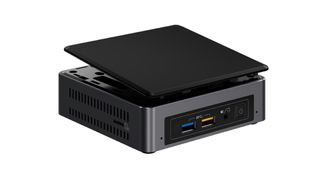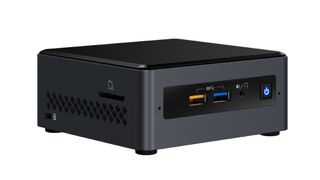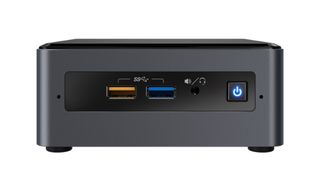
Updated, 3/8/2018, 8:45am PT: Intel released the NUC7CJYH and NUC7PJYH on its website. The kits cost $165 and $225, respectively, and their specs are identical to those published in the technical document. Intel has not yet released the NUC7CJYS system, which is the only one of these three products to ship with memory (4GB of DDR4-2400) and storage (32GB eMMC) installed.
Original article, 1/31/2018, 12pm PT:
New Intel NUC products have been detailed in a technical document. The upcoming embedded systems are built on the recently announced Gemini Lake platform, which replaces the Apollo Lake platform.
In total, three products are detailed in the document: two kits and one complete system. The NUC7CJYH and NUC7PJYH kits both come without memory, storage, or an OS. Where the two differ is in their CPUs. The NUC7CJYH has an embedded dual-core Celeron J4005, while the NUC7PJYH uses a quad-core Pentium Silver J5005. Both of these are listed with 10W TDPs, but the Pentium Silver will be the faster thanks to its higher turbo clock (2.8GHz vs 2.7GHz), extra cores (4 vs 2), and faster integrated GPU (Intel 605 with 18 EUs vs Intel 600 with 12 EUs). The only complete system, the NUC7CJYS, uses the slower Celeron CPU and also comes with 4GB of DDR4-2400 SO-DIMM memory, 32GB of e-MMC flash storage, and a Windows 10 Home license.
As we previously reported, Gemini Lake, as a platform, brings decode support for 10-bit video codecs and integrated HDMI 2.0. All of the products have two of these ports. The video improvements will make these new NUCs suitable for HDR content playback. Unfortunately, the CPUs’ six native PCI-E lanes aren’t going to very useful, because none of the NUCs have any M.2 slots. The only provisions for expanding storage are one 2.5” drive slot and an SDXC card slot. For wireless connectivity, all the NUCs feature Intel’s Wireless-AC 9462-D2W card, which supports 802.11ac WiFi and Bluetooth 5.
Gemini Lake is still a new platform, having only been announced in late 2017. We’re just starting to see products with it trickle out. These new NUCs haven’t been listed on Intel’s website yet, so we don’t have any pricing or availability information.
Stay on the Cutting Edge
Join the experts who read Tom's Hardware for the inside track on enthusiast PC tech news — and have for over 25 years. We'll send breaking news and in-depth reviews of CPUs, GPUs, AI, maker hardware and more straight to your inbox.
-
bit_user Reply
Does Intel even make discrete 1 Gbps Ethernet chips, any more? I assume they've moved on to higher-margin parts, like 10 and 100 Gbps.20655820 said:So why does it Intel Brand NUC have a Realtek network controller? -
Giroro I always thought the point of NUCs were to have high performance in a small pre-built package. That is why the upcoming intel + AMD graphics chips were possibly exciting.Reply
I can't even imagine something lower-end than these without dropping into the phone/tablet category. -
bit_user Reply
They all use laptop chips - mostly dual-core. So, I don't know exactly what you had in mind by high performance, but Apollo & Gemini Lake were built as entry-level laptop SoCs and so it makes sense for them to appear in entry-level NUCs. If you check the base price of these (or their Apollo Lake counterparts), they're actually pretty cost-effective.20658321 said:I always thought the point of NUCs were to have high performance in a small pre-built package. That is why the upcoming intel + AMD graphics chips were possibly exciting.
There are plenty of places (e.g. point-of-sale, reception desk, digital signage) where you need something powerful enough to run a modern OS, but nothing too fancy. I think that's what application they have in mind for these. -
Giroro Reply20658912 said:
They all use laptop chips - mostly dual-core. So, I don't know exactly what you had in mind by high performance, but Apollo & Gemini Lake were built as entry-level laptop SoCs and so it makes sense for them to appear in entry-level NUCs. If you check the base price of these (or their Apollo Lake counterparts), they're actually pretty cost-effective.20658321 said:I always thought the point of NUCs were to have high performance in a small pre-built package. That is why the upcoming intel + AMD graphics chips were possibly exciting.
There are plenty of places (e.g. point-of-sale, reception desk, digital signage) where you need something powerful enough to run a modern OS, but nothing too fancy. I think that's what application they have in mind for these.
I mean -relatively- high performance. The last time I looked at NUCs (Skull Canyon in particular) they were mostly i7's surrounded by a lot of marketing about how Intel's very-best integrated graphics could technically run DOTA 2 and play 4k video.
I assume they didn't sell very well, because their graphics are still pretty awful... But as far as I know the push for NUCs were the reason Intel released their (now cancelled) Iris Pro graphics.
It always felt like intel was branding NUCs as "small form factor with no compromises", because their low-end SOCs (Atom, Apollo, Gemini lake,) can go so much smaller than a NUC.
I think the market for a $150 NUC (add your own storage and OS) probably isn't very large when for the same price you can get an entry level Windows 10 tablet or laptop - which have the bonus of a functional screen and battery.
So at that point I guess it all comes down to pricing and if they improve their form factor... A $99 NUC with 32GB emmc and windows (whatever limited version these low end devices get) and an empty 2.5" bay in a package that isn't much bigger than the 2.5" drive itself could be appealing to a lot of people... But $150 for a NUC plus $99 for retail windows 10 plus $20+ for storage and $50+ for RAM -that you then have to assemble in something the size of a large book... You would be over $300 with the minimum possible configuration - which doesn't include a monitor, mouse, or keyboard. For home users, there's just better options available.
Even for a Linux-powered terminal at a library or POS or something like that, I think this is a hard sell over an all-in-one style computer.
-
bit_user Reply
I don't know if every generation has a gaming SKU, but most NUCs are not marketed towards gamers.20662094 said:The last time I looked at NUCs (Skull Canyon in particular) they were mostly i7's surrounded by a lot of marketing about how Intel's very-best integrated graphics could technically run DOTA 2 and play 4k video.
No, I'm sure that was for high-end ultrabooks. Then, as with the rest of the NUC lineup, they just took a handful of laptop SoCs and stuffed them into NUCs to sell on the side.20662094 said:as far as I know the push for NUCs were the reason Intel released their (now cancelled) Iris Pro graphics.
Well, you can use them for embedded or maybe tablets, but they cancelled the SoCs for anything smaller (e.g. phones). You have to go all the way down to wearables and IoT, before Intel has any x86 to offer (in the form of their 32-bit Edison chip).20662094 said:It always felt like intel was branding NUCs as "small form factor with no compromises", because their low-end SOCs (Atom, Apollo, Gemini lake,) can go so much smaller than a NUC.
That's really kind of apples & oranges. These NUCs have wired ethernet, toslink, more USB, and can accommodate more RAM and much more storage than those laptops - which typically have both their (single-channel) RAM and EMMC storage soldered down. NUCs also have microphone arrays, and I don't know if those usually work on laptops if you're using it with the lid closed.20662094 said:I think the market for a $150 NUC (add your own storage and OS) probably isn't very large when for the same price you can get an entry level Windows 10 tablet or laptop - which have the bonus of a functional screen and battery.
Someone who wants portability will not even look at the NUC, whereas someone who doesn't care about portability will get a smaller footprint, more features, and better performance with the NUC.
Among their peers, these NUCs are definitely premium-priced. However, if you compare features and performance with the all-in-ones you mention, I think it's hard to do much better than a NUC.20662094 said:Even for a Linux-powered terminal at a library or POS or something like that, I think this is a hard sell over an all-in-one style computer.
I find it interesting that you're even arguing this point, since you've indicated that you really haven't followed this product line. You would do well to familiarize yourself more with the NUCs and competing product offerings, if this is something that interests you. -
Eximo I can think of lots of uses for these types of systems, though the price is a little steep at the moment. I usually wait for the third party ones to show up.Reply
I was more interested in the ones with vega graphics, but a laptop with a discrete GPU is cheaper then their barebones kit, by a lot, so not really sure what the idea there is. I can't really conceive of when a sff desktop or ultrabook would be worse then a NUC with vega. Given the availability of VESA mount chassis...
But the ones with Iris pro graphics weren't bad at all. I have a few applications where all I need is a modern browser but the screen is fixed in place, so a tablet would be inconvenient to constantly be swapping out. But a little NUC can be replaced or upgraded as needed.
Also have one of those Atom stick computers. Pretty decent for streaming audio and 720p video, though the lack of I/O makes a NUC more appealing.
Libraries should stick to whatever their grant appropriations lets them buy. No need for expensive toys that are easy to pocket. Standard SFF desktops make more economical sense. -
viesturs.r Specs table for both says "Cooling - Passive", which is possibly not correct. otherwise that could be significal improvement comparing with nuc6cayh which has cooling fan.Reply -
photonboy Plenty of uses for low-powered, low-memory computers. Not everybody games. In fact, some are useful for just simple DATA ENTRY at hospitals or other businesses.Reply
The "point" was never to have a powerful PC in a small footprint if you go back to when the Intel NUC started.
In fact as per the article some of these only have 32GB of drive memory which frankly is unacceptable... I've already dealt with several PC's that give ERRORS due to running out of space even though the ONLY main thing done is Windows Updates.
Errors like "not enough space to upgrade"... the USB HDD approach failed forcing me to reinstall Windows which is fine for ME but not for others. -
rcprimak Reply20781508 said:Plenty of uses for low-powered, low-memory computers. Not everybody games. In fact, some are useful for just simple DATA ENTRY at hospitals or other businesses.
The "point" was never to have a powerful PC in a small footprint if you go back to when the Intel NUC started.
In fact as per the article some of these only have 32GB of drive memory which frankly is unacceptable... I've already dealt with several PC's that give ERRORS due to running out of space even though the ONLY main thing done is Windows Updates.
Errors like "not enough space to upgrade"... the USB HDD approach failed forcing me to reinstall Windows which is fine for ME but not for others.
You misread the specs from the article. 32GB is the maximum system RAM, not the storage. Storage is typically 512GB on an SSD which you add to the barebones system.
Most Popular




